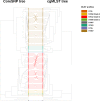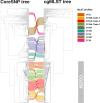Comparison of core-genome MLST, coreSNP and PFGE methods for Klebsiella pneumoniae cluster analysis
- PMID: 32149598
- PMCID: PMC7276701
- DOI: 10.1099/mgen.0.000347
Comparison of core-genome MLST, coreSNP and PFGE methods for Klebsiella pneumoniae cluster analysis
Abstract
In this work we compared the most frequently used Klebsiella pneumoniae typing methods: PFGE, cgMLST and coreSNP. We evaluated the discriminatory power of the three methods to confirm or exclude nosocomial transmission on K. pneumoniae strains isolated from January to December 2017, in the framework of the routine surveillance for multidrug-resistant organisms at the San Raffaele Hospital, in Milan. We compared the results of the different methods to the results of epidemiological investigation. Our results showed that cgMLST and coreSNP are more discriminant than PFGE, and that both approaches are suitable for transmission analyses. cgMLST appeared to be inferior to coreSNP in the K. pneumoniae CG258 phylogenetic reconstruction. Indeed, we found that the phylogenetic reconstruction based on cgMLST genes wrongly clustered ST258 clade1 and clade2 strains, conversely properly assigned by coreSNP approach. In conclusion, this study provides evidences supporting the reliability of both cgMLST and coreSNP for hospital surveillance programs and highlights the limits of cgMLST scheme genes for phylogenetic reconstructions.
Keywords: CG258; K. pneumoniae; cgMLST; cluster.
Conflict of interest statement
The authors declare that there are no conflicts of interest.
Figures




Similar articles
-
Epidemiology of Staphylococcus aureus food isolates: Comparison of conventional methods with whole genome sequencing typing methods.Food Microbiol. 2025 Jan;125:104625. doi: 10.1016/j.fm.2024.104625. Epub 2024 Sep 2. Food Microbiol. 2025. PMID: 39448143
-
A Two-Year Surveillance in Five Colombian Tertiary Care Hospitals Reveals High Frequency of Non-CG258 Clones of Carbapenem-Resistant Klebsiella pneumoniae with Distinct Clinical Characteristics.Antimicrob Agents Chemother. 2015 Oct 26;60(1):332-42. doi: 10.1128/AAC.01775-15. Print 2016 Jan. Antimicrob Agents Chemother. 2015. PMID: 26503660 Free PMC article.
-
Multiple-Locus Variable Number Tandem Repeat Analysis of Klebsiella pneumoniae: Comparison with Pulsed-Field Gel Electrophoresis.Microb Drug Resist. 2017 Jul;23(5):626-632. doi: 10.1089/mdr.2016.0107. Epub 2016 Dec 13. Microb Drug Resist. 2017. PMID: 27960064
-
Tracking a hospital outbreak of KPC-producing ST11 Klebsiella pneumoniae with whole genome sequencing.Clin Microbiol Infect. 2015 Nov;21(11):1001-7. doi: 10.1016/j.cmi.2015.07.001. Epub 2015 Jul 10. Clin Microbiol Infect. 2015. PMID: 26166545
-
Epidemiological typing of multidrug-resistant Klebsiella pneumoniae, which causes paediatric ventilator-associated pneumonia in Egypt.J Med Microbiol. 2017 May;66(5):628-634. doi: 10.1099/jmm.0.000473. Epub 2017 May 9. J Med Microbiol. 2017. PMID: 28485710
Cited by
-
Comparative analysis of two genomes of Chlamydia pecorum isolates from an Alpine chamois and a water buffalo.BMC Genomics. 2022 Sep 10;23(1):645. doi: 10.1186/s12864-022-08860-7. BMC Genomics. 2022. PMID: 36088280 Free PMC article.
-
Presence and infectivity of SARS-CoV-2 virus in wastewaters and rivers.Sci Total Environ. 2020 Nov 20;744:140911. doi: 10.1016/j.scitotenv.2020.140911. Epub 2020 Jul 14. Sci Total Environ. 2020. PMID: 32693284 Free PMC article.
-
Rapid Open-Source SNP-Based Clustering Offers an Alternative to Core Genome MLST for Outbreak Tracing in a Hospital Setting.Front Microbiol. 2021 Apr 1;12:636608. doi: 10.3389/fmicb.2021.636608. eCollection 2021. Front Microbiol. 2021. PMID: 33868194 Free PMC article.
-
Whole-genome sequencing surveillance and machine learning for healthcare outbreak detection and investigation: A systematic review and summary.Antimicrob Steward Healthc Epidemiol. 2022 Jun 13;2(1):e91. doi: 10.1017/ash.2021.241. eCollection 2022. Antimicrob Steward Healthc Epidemiol. 2022. PMID: 36483409 Free PMC article. Review.
-
Antimicrobial Susceptibility, Virulence, and Genomic Features of a Hypervirulent Serotype K2, ST65 Klebsiella pneumoniae Causing Meningitis in Italy.Antibiotics (Basel). 2022 Feb 17;11(2):261. doi: 10.3390/antibiotics11020261. Antibiotics (Basel). 2022. PMID: 35203864 Free PMC article.
References
-
- Giani T, Antonelli A, Caltagirone M, Mauri C, Nicchi J, et al. Evolving beta-lactamase epidemiology in Enterobacteriaceae from Italian nationwide surveillance, October 2013: KPC-carbapenemase spreading among outpatients. Euro Surveill. 2017;22:pii: 30583. doi: 10.2807/1560-7917.ES.2017.22.31.30583. - DOI - PMC - PubMed

